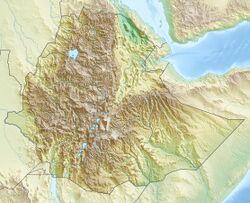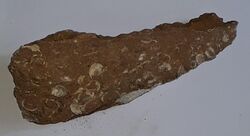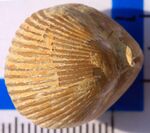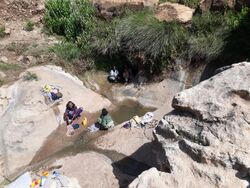Earth:Antalo Limestone
| Antalo Limestone Stratigraphic range: Oxfordian-Kimmeridgian ~163–153 Ma | |
|---|---|
 Formation at Kurkura village (Dogua Tembien), holding St. Mika'el's cave | |
| Type | Geological formation |
| Underlies | Mugher Mudstone |
| Overlies | Adigrat Sandstone |
| Thickness | 800 m (2,600 ft) |
| Lithology | |
| Primary | Limestone, marl, calcareous sandstone |
| Other | Grainstone, wackestone |
| Location | |
| Coordinates | [ ⚑ ] : 13°35′52″N 39°16′38″E / 13.5977°N 39.2772°E |
| Paleocoordinates | [ ⚑ ] 7°30′S 26°36′E / 7.5°S 26.6°E |
| Region | Tigray |
| Country | |
| Extent | Mekelle Outlier, Danakil Alps |
| Type section | |
| Named for | Antalo town |
| Named by | William Thomas Blanford |
| Year defined | 1868 |
The Antalo Limestone, also known as the Antalo Sequence, is a geological formation in Ethiopia. It is between 300 and 800 metres thick and comprises fossiliferous limestones and marls that were deposited in a reef. Marine microfossils have shown an age between 165 and 150 million years.[1][2]
Name and definition
The Antalo Supersequence includes two main stratigraphic units: the Antalo Sequence and the Agula Group.[2][3] The Antalo Sequence, or Antalo Limestone has been named after the town of Hintalo in Tigray, Ethiopia. The name of the formation was coined by geologist William Thomas Blanford, who accompanied the British Expedition to Abyssinia in 1868.[4] At that time, Hintalo was a major town on the route of the invading British army.[5] So far the nomenclature has not been proposed for recognition to the International Commission on Stratigraphy.
Geographical extent
The sedimentary succession is found in Ethiopia, in the Mekelle Outlier, in the Blue Nile gorge, in the Harrar Plateau and around Dire Dawa.[2]
Stratigraphic context
The Antalo Limestone overlies the Adigrat Sandstone, and is covered by the Agula Group or Agula Shale and the Mugher Mudstone.
Environment
The Antalo Limestone comprises sediment that was deposited in a shallow tropical sea in the upper Jurassic. As the region had undergone a marine transgression, it was below the sea level. At that time, what would become Ethiopia was positioned just south of the equator.[6]
Lithology
The limestones and marls of the Antalo Sequence also hold shale and calcareous sandstone layers. The Antalo Limestone comprises four members: (1) a basal member with grainstone and wackestone lithologies, with marly interlayers and in the upper part stromatoporoid coral-like level; (2) sandy limestone deposited in estuaries and lagoons; (3) micritic (very fine grained) limestone with intercalations of wackestone and coquina beds deposited in relatively deep water; and (4) a succession of marls and limestone, with cherty limestone at the base.[2][3]
Fossil content
The Antalo Limestone sediments were deposited at the time of dinosaurs and primitive birds. Well away from coasts, coral reefs formed the edge of the continental shelf. At shallow depth, the sea bottom was made of large mudflats, with sand bars and spits near river mouths.[6] This sea bed hosted many invertebrate animals: echinoderms, crustaceans, bivalves and gastropods were common. There was also fish. As it was not a nutrient-rich ecosystem, larger predators were rare, maybe some marine reptiles like crocodiles. A striking scavenger in this fauna was a cephalopod mollusc, a giant nautilus with a characteristic spiral shell.[6]
Invertebrates
- Bivalves
| Bivalves of the Antalo Limestone.[7] | |||||
|---|---|---|---|---|---|
| Genus | Species | Presence | Material | Notes | Images |
| Actinostreon | A. solitarium | 10 specimens from AL1, 65 from AL2. | 75 specimens. | A palaeolophid. | |
| Arcomytilus | A. laitmairensis | AL1 and AL2. | 3 left valves, 1 right valve and 4 articulated specimens. | A mytilid. | |
| Eopecten | E. velatus | AL1. | 1 left valve. | A pectinid. | |
| Gryphaea | G.? (Bilobissa?) balli | AL1. | 1 left valve. | A gryphaeid. | |
| Integricardium | I. (Integricardium) cf. bannesianum | 7 specimens from AL1, 1 from AL2. | 4 left valves, 1 right valves and 3 double-valved specimens. | A cardiid. | |
| Liostrea | L. sp. | AL1 and AL2. | 2 specimens. | An ostreid. | |
| "Lucina" | "L." cf. cecchii | AL2. | 4 double-valved specimens. | A lucinid. | |
| Modiolus | M. (Modiolus) imbricatus | 2 specimens from AL1, 1 from AL2. | 3 double-valved specimens. | A mytilid. | |
| Musculus | M. (Musculus) somaliensis | AL1 and AL2. | 2 articulated specimens. | A mytilid. | |
| Nanogyra | N. nana | AL2. | 2 articulated specimens. | A gryphaeid. | |
| Pholadomya | P. (Bucardiomya) somaliensis | 1 specimen from AL1, 6 from AL2. | 7 double-valved specimens. | A pholadomyid. | |
| P. (Bucardiomya) lirata | AL2. | 1 double-valved specimen. | A pholadomyid. | ||
| Plagiostoma | P. harronis | AL1 and AL2. | 3 left valves, 5 right valves and 2 articulated specimens. | A limid. | |
| P. sublaeviusculum | AL2. | 1 left valve 1 right valve and 1 articulated specimen. | A limid. | ||
| Seebachia | S. ("Eoseebachia") sowerbyana | AL2. | 2 left valves. | An astartid. | |
| Spondylopecten | S. (Spondylopecten) palinurus | AL1. | 2 left valves. | A pectinid. | |
| Stegoconcha | S. gmuelleri | AL2. | 2 articulated specimens. | A pinnid. | |
- Brachiopods
| Brachiopods of the Antalo Limestone[7] | |||||
|---|---|---|---|---|---|
| Genus | Species | Presence | Material | Notes | Images |
| cf. Amydroptychus | cf. A. sp. | Base of AL2. | 10 individuals. | A rhynchonellid. | |
| Cererithyris | C. sp. | 1 from AL1, 105 from AL2 . | 106 individuals. | A terebratulid. | |
| Cymatorhynchia | C. sp. | AL2. | 16 individuals. | A rhynchonellid. | |
| Daghanirhynchia | D. sp. | 3 individuals from AL1, 51 from AL2. | 54 individuals. | A rhynchonellid. | |
| Monsardithyris | M. sp. | AL2. | 20 individuals. | A terebratulid. | |
| Somalirhynchia | S. africana | Mostly from AL2. | More than 100 individuals. | A rhynchonellid. | |
- Cnidarian
| Cnidarians of the Antalo Limestone[7] | |||||
|---|---|---|---|---|---|
| Genus | Species | Presence | Material | Notes | Images |
| Actinastrea | A. crassoramosa | 47 specimens from AL1, 13 from AL2. | 60 larger fragments of colonies. | A stony coral. | |
| Coenastraea | C. arabica | AL2. | 1 specimen. | A stony coral. | |
| Collignonastraea | C. cf. grossouvrei | AL2. | 1 specimen. | A stony coral. | |
| Columnocoenia | C. gemmans | AL1. | 2 specimens. | A stony coral. | |
| Comoseris | C. meandrinoides | AL3. | 1 complete colony. | A stony coral. | |
| Cladophyllia | C. excelsa | AL3. | 1 specimen. | A stony coral. | |
| Cryptocoenia | C. slovenica | 7 specimens from AL1, 4 specimens from AL2. | 11 specimens. | A stony coral. | |
| Ironella | I. arabica | AL1. | 12 specimens. | A stony coral. | |
| Isastrea | I. bernensis | 20 specimens from AL1, 22 specimens from AL2. | 42 specimens. | A stony coral. | |
| Kobyastraea | K. lomontiana | AL1. | 1 specimen. | A stony coral. | |
| Latiastrea | L. greppini | 2 from AL1, 3 from AL2. | 5 specimens. | A stony coral. | |
| Lochmaeosmilia | L. trapeziformis | AL1. | 16 karger fragments of colonies. | A stony coral. | |
| Ovalastrea | O. michelini | AL2. | 3 specimens (including 1 complete colony). | A stony coral. | |
- Echinoderms
| Echinoderms of the Antalo Limestone | |||||
|---|---|---|---|---|---|
| Genus | Species | Presence | Material | Notes | Images |
| Ausichicrinites | A. zelenskyyi | Nearly complete specimen.[8] | A comatulid. | ||
| Pygurus | P. meslei | Upper part of the formation.[9] | A sea urchin. | ||
- Molluscs
| Molluscs of the Antalo Limestone[10] | |||||
|---|---|---|---|---|---|
| Genus | Species | Presence | Material | Notes | Images |
| Orthosphinctes | O. aff. tiziani | Top part of sub-unit II. | 5 fragmentary specimens. | An ataxioceratid ammonite. | |
| Pachyceras | P. cf. lalandeanum | From the middle part of sub-unit II, GPS location 10°02′39.7″N, 38°13′53.7″E. | One poorly preserved specimen (no. AF020). | A pachyceratid ammonite. | |
| Paracenoceras | P. cf. ennianus | Top part of sub-unit II. | 1 specimen (no. AF012). | A nautiloid. | |
| P. aff. prohexagonum | Lower Limestone Member.[11] | A nautiloid. | |||
| P. cf. kumagunense | Top part of sub-unit II. | 1 specimen (no. AF004). | A nautiloid. | ||
| P. cf. giganteum | Middle part of sub-unit II. | 1 specimen (no. AF005). | A nautiloid. | ||
| Purpuroidea | P. aff. gigas | One specimen (AF025) from the top part of sub-unit I; One specimen (AF026) from the top part of sub-unit II. | 2 specimen (AF025 and AF026). | A gastropod. | |
Limestone and karst geomorphology
The layering is sub-horizontal, the same as that of the underlying sedimentary formations.[3] This gives rise to a structural sub-horizontal relief, with alternating cliffs and flats. Dissolution processes in limestone lead to the occurrence of caves. Most described caves in Mesozoic limestone in Ethiopia are located in the Harrar region (Sof Omar cave) and in the Dogu’a Tembien district of Tigray.[12]
Traditional uses of Antalo Limestone
Given its nearly rectangular shape and its strength, the hard layers of Antalo Limestone are used for
- House building. Traditionally, fermented mud will be used as mortar
- Fencing of homesteads, generally in dry masonry
- Milling stone: for this purpose plucked-bedrock pits, small rock-cut basins that naturally occur in rivers with kolks, are excavated from the river bed and further shaped. Milling is done at home using an elongated small boulder (mano)[13][14]
- Door and window lintels
- Footpath paving
- Stone bunds or gedeba: terrace walls in dry masonry, typically laid out along the contour for sake of soil and water conservation
- Check dams in gullies for sake of gully erosion control
- Cobble stones, sold to the towns for paving secondary streets
See also
References
- ↑ Sembroni, A.; Molin, P.; Dramis, F. (2019). Regional geology of the Dogu'a Tembien massif. In: Geo-trekking in Ethiopia's Tropical Mountains - The Dogu'a Tembien District. SpringerNature. ISBN 978-3-030-04954-6. https://www.springer.com/gp/book/9783030049546.
- ↑ 2.0 2.1 2.2 2.3 Bosellini, A.; Russo, A.; Fantozzi, P.L.; Assefa, G.; Tadesse, S. (1997). "The Mesozoic succession of the Mekelle Outlier (Tigrai Province, Ethiopia)". Mem. Sci. Geol. 49: 95–116.
- ↑ 3.0 3.1 3.2 Dramis, F.; Fubelli, G. (2019). "Limestone, Karst and Tufa Dams in the Western Part of the Mekelle Outlier". Geo-trekking in Ethiopia's Tropical Mountains. GeoGuide. Cham (CH): SpringerNature. pp. 107–119. doi:10.1007/978-3-030-04955-3_7. ISBN 978-3-030-04954-6.
- ↑ Blanford, W.T. (1870). Observations on the geology and zoology of Abyssinia, made during the progress of the British expedition to that country in 1867-68. London: Macmillan and Co.. https://archive.org/details/cu31924024736666.
- ↑ Markham, C.; Prideaux, W. (1869). A history of the Abyssinian expedition. Macmillan.
- ↑ 6.0 6.1 6.2 Lerouge, F.; Aerts, R. (2019). Fossil evidence of Dogu'a Tembien's environmental past. In: Geo-Trekking in Ethiopia's Tropical Mountains, the Dogu'a Tembien District.. SpringerNature. ISBN 978-3-030-04954-6. https://www.springer.com/gp/book/9783030049546.
- ↑ 7.0 7.1 7.2 Kiessling, Wolfgang; Pandey, Dhirendra Kumar; Schemm-Gregory, Mena; Mewis, Heike; Aberhan, Martin (2011). "Marine benthic invertebrates from the Upper Jurassic of northern Ethiopia and their biogeographic affinities". Journal of African Earth Sciences 59 (2–3): 195. doi:10.1016/j.jafrearsci.2010.10.006. ISSN 1464-343X. https://www.academia.edu/12856498.
- ↑ Salamon, Mariusz A.; Jain, Sreepat; Brachaniec, Tomasz; Duda, Piotr; Płachno, Bartosz J.; Gorzelak, Przemysław (2022). "Ausichicrinites zelenskyyi gen. et sp. nov., a first nearly complete feather star (Crinoidea) from the Upper Jurassic of Africa". Royal Society Open Science 9 (7): 220345. doi:10.1098/rsos.220345. PMID 35875469.
- ↑ Radwańska, Urszula; Jain, Sreepat (2020-10-01). "First Late Jurassic echinoid record of Pygurus meslei Gauthier from the Antalo Limestone Formation (Blue Nile Basin, Ethiopia)" (in en). Journal of African Earth Sciences 170: 103898. doi:10.1016/j.jafrearsci.2020.103898. ISSN 1464-343X. https://www.sciencedirect.com/science/article/pii/S1464343X20301497.
- ↑ Jain, Sreepat; Schmerold, Roland (2021). "Callovian and Kimmeridgian fossils and stratigraphy of the Blue Nile Basin (central western Ethiopia)". Annales Societatis Geologorum Poloniae. doi:10.14241/asgp.2021.11. ISSN 0208-9068.
- ↑ Jain, Sreepat (2019-01-01). "First Bathonian (Middle Jurassic) nautiloid Paracenoceras Spath from Ethiopia" (in en). Journal of African Earth Sciences 149: 84–96. doi:10.1016/J.JAFREARSCI.2018.07.027. ISSN 1464-343X. https://typeset.io/papers/first-bathonian-middle-jurassic-nautiloid-paracenoceras-29cc2a6iuu.
- ↑ Catlin, D; Largen, M; Monod, T; Morton, W (1973). "The caves of Ethiopia.". Transactions of the Cave Research Group of Great Britain 15: 107–168.
- ↑ Nixon-Darcus, L.A. (2014). The cultural context of food grinding equipment in Northern Ethiopia: an ethnoarchaeological approach. PhD thesis. Canada: Simon Frazer University. http://summit.sfu.ca/item/14597.
- ↑ Gebre Teklu (2012). Ethnoarchaeological study of grind stones at Lakia'a in Adwa, Tigray Regional State, Ethiopia. PhD diss.. Addis Ababa University. http://213.55.95.56/bitstream/handle/123456789/439/Gebre%20Teklu.pdf?sequence=1&isAllowed=y.
 |











